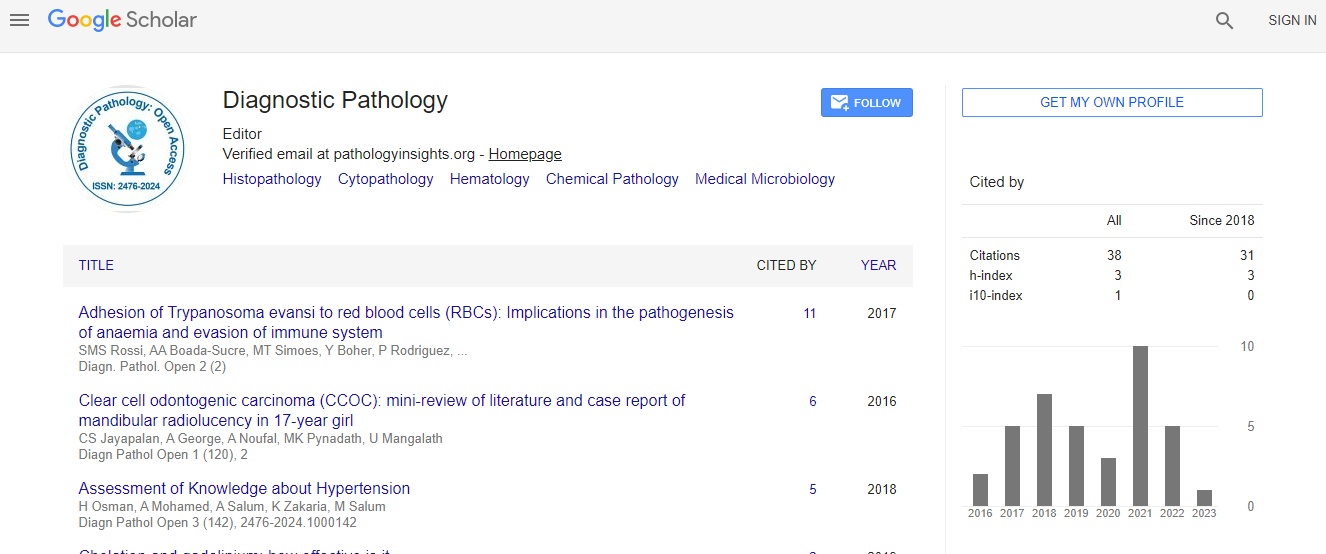Our Group organises 3000+ Global Conferenceseries Events every year across USA, Europe & Asia with support from 1000 more scientific Societies and Publishes 700+ Open Access Journals which contains over 50000 eminent personalities, reputed scientists as editorial board members.
Open Access Journals gaining more Readers and Citations
700 Journals and 15,000,000 Readers Each Journal is getting 25,000+ Readers
Google Scholar citation report
Citations : 110
Diagnostic Pathology: Open Access received 110 citations as per Google Scholar report
Diagnostic Pathology: Open Access peer review process verified at publons
Indexed In
- Google Scholar
- RefSeek
- Hamdard University
- EBSCO A-Z
- Publons
- Euro Pub
- ICMJE
Useful Links
Share This Page
Overcoming spurious hyperkalemia due to platelets
13th International Conference on Laboratory Medicine & Pathology
Suhanyah Mahathevan, Siriwardene S C and Hewamana S
Lanka Hospitals Diagnostics, Sri Lanka Lanka Hospital, Sri Lanka
Posters & Accepted Abstracts: Diagn Pathol Open
Abstract
Background: The occurrence of spuriously high serum potassium levels have been associated with high platelet counts. It is due to the degranulation of platelets during clotting in vitro, releasing potassium into the serum. Case Presentation: A 69-year-old man was admitted following a fall. On admission the white cell count was 12,920/├?┬ÁL, hemoglobin 83 g/L and the platelet count 1,550,000/├?┬ÁL (150,000-450,000). Serum sodium, potassium and chloride were respectively 141, 5.8 (3.5-5.1) and 113 mmol/L respectively. Plasma sodium, potassium and chloride (on a sample collected into lithium heparin at the same time) were 141, 4.3 and 112 mmol/L, respectively. Serum creatinine was 1.5 mg/dL (0.81.3). The blood picture showed macrocytes and spherocytes with normal leucocytes, together with severe thrombocytosis. Bone marrow was normocellular and had increased megakaryocytes with some dysplastic forms. Platelet lakes/clumps were prominent. The myeloid series was normal and the erythroid series had reduced precursors. The trephine biopsy showed increased megakaryocytes with clustering, without significant fibrosis. JAK2 V617F mutation was detected. The patient was diagnosed to have essential thrombocythemia. Discussion: This case illustrates the occurrence of spurious hyperkalemia associated with marked thrombocytosis. The collection of a sample into lithium heparin at the same time, allowed the laboratory to issue the true potassium level. Essential thrombocythemia is identified by an increased platelet count due to abnormal pluripotent stem cell proliferation resulting in excessive megakaryocyte division. The above investigations supports this diagnosis as against a secondary thrombocythemia. The clinical complications involve the sequela of abnormal platelet function, namely haemorrhage or thrombosis. Potassium measurement should be performed in a plasma sample (and not in serum) in the presence of marked thrombocytosis.Biography
I am Suhanyah Mahathevan. I work as a Biomedical Scientist in Lanka Hospital Diagnostics, Sri lanka.My education qualifications: BSC (Chemistry,Graduate Chemist),MSC (Biomedical Science,University of East London,UK),MBA(University of Kelaniya),International Specialist in Chemistry from American Society of Clinical Pathology (SC- ASCP),Srilanka Medical Council Registered Medical Technologist ( Reg No:2178).
E-mail: Suhi14@yahoo.com

 Spanish
Spanish  Chinese
Chinese  Russian
Russian  German
German  French
French  Japanese
Japanese  Portuguese
Portuguese  Hindi
Hindi 
